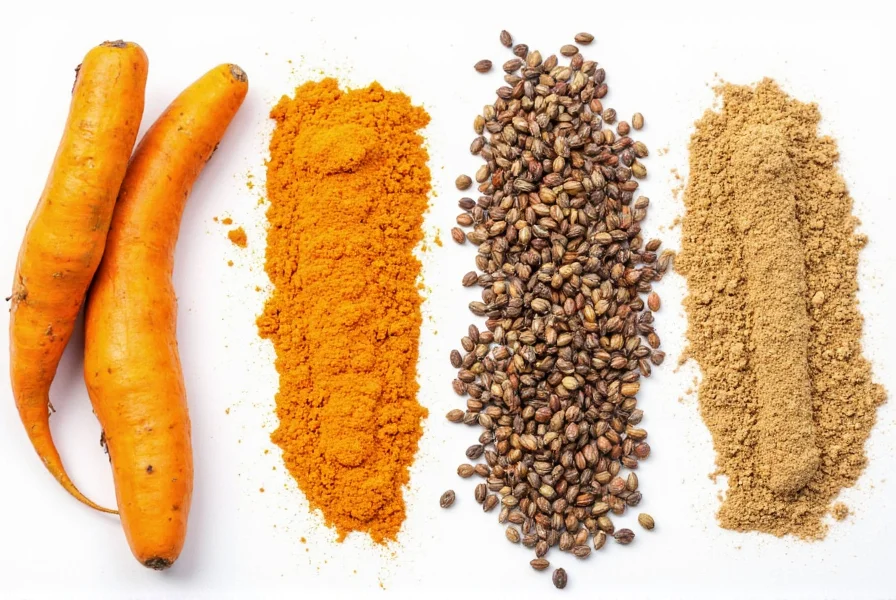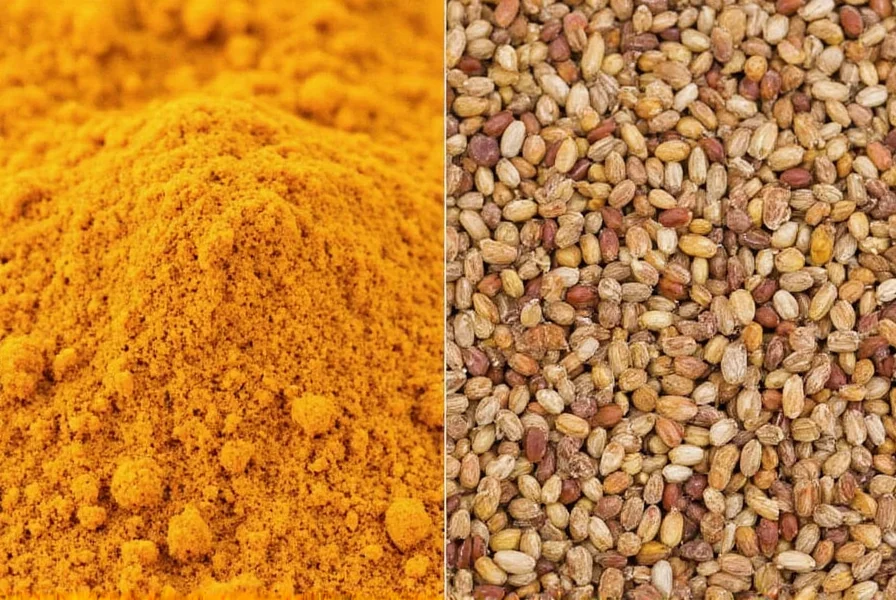Understanding the differences between turmeric and cumin transforms your cooking experience. These two staple spices frequently appear in global cuisines but serve distinctly different purposes in the kitchen. While both enhance flavor profiles and add depth to dishes, their chemical compositions, taste characteristics, and culinary applications vary significantly. This comprehensive comparison helps home cooks and culinary enthusiasts make informed decisions when selecting between these spices for various recipes.
Botanical Origins and Historical Background
Turmeric (Curcuma longa) belongs to the ginger family and grows as a rhizome underground. Native to Southeast Asia and India, this golden spice has been used for over 4,000 years in traditional Ayurvedic medicine and culinary practices. Ancient Indian texts document turmeric's use in religious ceremonies, textile dyeing, and as a medicinal herb.
Cumin (Cuminum cyminum) comes from the seeds of a flowering plant in the parsley family. Originating in the Eastern Mediterranean region, archaeological evidence shows cumin use dating back to ancient Egyptian times. Both spices traveled along historic trade routes, becoming essential components in regional cuisines worldwide. Understanding the historical context of turmeric versus cumin reveals why certain cultures incorporate them differently in traditional dishes.
Physical Characteristics Comparison
| Characteristic | Turmeric | Cumin |
|---|---|---|
| Form | Rhizome (fresh) or powder | Seeds (whole) or powder |
| Color | Vibrant yellow-orange | Light to medium brown |
| Aroma | Earthy, slightly medicinal | Warm, nutty, peppery |
| Taste Profile | Bitter, earthy, peppery | Warm, nutty, slightly smoky |
| Texture (powdered) | Finer, smoother | Slightly coarser |
The visual distinction between these spices couldn't be more pronounced. Fresh turmeric resembles ginger but with intense orange flesh, while dried turmeric powder creates that signature golden hue in curries. Cumin seeds appear as small, crescent-shaped grains that darken when toasted, releasing their characteristic aroma. When comparing turmeric versus cumin appearance and texture, their differences immediately impact how they interact with other ingredients in cooking.

Flavor Chemistry and Culinary Impact
Turmeric's primary active compound, curcumin, contributes both its color and distinctive earthy-bitter flavor. This compound remains relatively stable during cooking but requires fat for optimal absorption. The spice works exceptionally well in slow-cooked dishes where its flavor can mellow and integrate with other ingredients.
Cumin's dominant compound, cuminaldehyde, creates its warm, nutty profile that intensifies when toasted. Unlike turmeric, cumin benefits from dry roasting before grinding, which enhances its aromatic compounds. Professional chefs often note that understanding turmeric versus cumin flavor chemistry helps determine when to add each spice during cooking—cumin early for base flavors, turmeric later to preserve its delicate notes.
Nutritional Composition and Health Considerations
Both spices offer notable nutritional benefits, though their profiles differ significantly. Turmeric contains curcuminoids, with curcumin being the most studied for its potential anti-inflammatory properties. Research suggests these compounds may support joint health and cognitive function, though bioavailability remains a challenge without proper pairing with black pepper or fats.
Cumin provides substantial iron content (providing about 20% of daily needs per teaspoon), along with manganese, magnesium, and calcium. It contains compounds like thymol that may support digestion. When examining nutritional differences between turmeric and cumin, neither serves as a primary nutrient source, but both contribute valuable phytochemicals to a balanced diet.
Culinary Applications Across Global Cuisines
Turmeric forms the golden foundation of many Indian curries, Middle Eastern rice dishes, and Southeast Asian marinades. Its staining properties make it ideal for giving color to mustards, cheeses, and rice dishes like Persian tahdig. In Caribbean cooking, turmeric appears in jerk seasoning blends, while in Western cuisine it's increasingly used in golden milk and wellness-focused recipes.
Cumin features prominently in Mexican chili powders, North African tagines, Indian garam masala, and Middle Eastern falafel. Whole cumin seeds often start Indian tempering (tadka), while ground cumin enhances spice rubs for meats. Understanding when to use turmeric instead of cumin in recipes prevents flavor imbalances—turmeric for earthy color and subtle bitterness, cumin for warm, nutty depth.
Substitution Guidance and Common Mistakes
While turmeric and cumin sometimes appear together in spice blends, they're not interchangeable. Substituting one for the other dramatically alters a dish's flavor profile. When facing a turmeric versus cumin substitution dilemma, consider these alternatives:
- For turmeric: A pinch of saffron (for color) plus a touch of ginger (for earthiness)
- For cumin: Coriander seeds (for similar earthiness but milder)
- In curry blends: Adjust other spices to compensate for missing element
Many home cooks mistakenly believe these spices can substitute for each other due to their frequent co-occurrence in curry powders. However, this misunderstanding often leads to unbalanced flavors. The key difference in using turmeric versus cumin in Indian cooking lies in their complementary rather than interchangeable roles.
Storage Recommendations for Maximum Freshness
Both spices lose potency when exposed to light, heat, and moisture. Store turmeric and cumin in airtight containers away from direct sunlight. Ground spices maintain peak flavor for 6-12 months, while whole cumin seeds stay fresh for up to 2 years. For extended shelf life, refrigerate both spices in opaque containers.
Professional chefs recommend buying whole cumin seeds and grinding them as needed, while turmeric is typically purchased as powder due to the difficulty of grinding fresh rhizomes at home. When comparing storage differences between turmeric and cumin, both require similar conditions but cumin's seed form gives it a slight longevity advantage.
Practical Usage Tips for Home Cooks
Maximize the potential of both spices with these evidence-based techniques:
- Bloom spices in oil: Heat turmeric and cumin in cooking fat before adding liquids to enhance flavor release
- Layer flavors: Add cumin early in cooking for base notes, turmeric later to preserve delicate compounds
- Balance bitterness: Counter turmeric's natural bitterness with small amounts of acid or sweetness
- Control staining: Use gloves when handling fresh turmeric and clean surfaces immediately
- Pair wisely: Combine turmeric with black pepper and healthy fats for better absorption
Understanding these practical applications transforms how to use turmeric versus cumin effectively in everyday cooking. The most successful dishes featuring these spices balance their unique properties rather than treating them as interchangeable ingredients.
Conclusion: Making Informed Spice Choices
Turmeric and cumin each bring distinctive qualities to culinary creations. Turmeric's earthy bitterness and vibrant color make it indispensable for certain dishes, while cumin's warm nuttiness forms the backbone of many global spice blends. Recognizing their differences—from flavor chemistry to cultural applications—empowers cooks to use each spice intentionally. Rather than viewing them as competitors, consider how these spices complement each other in well-balanced recipes. The next time you reach for your spice cabinet, you'll understand exactly when to use turmeric versus cumin for optimal results.
Frequently Asked Questions
Can I substitute cumin for turmeric in curry?
No, cumin cannot effectively substitute for turmeric in curry. They have completely different flavor profiles and visual properties. Turmeric provides the characteristic yellow color and earthy base note, while cumin adds warm, nutty depth. Substituting one for the other will dramatically alter the dish's flavor and appearance.
Which spice is healthier, turmeric or cumin?
Both spices offer unique health benefits. Turmeric contains curcumin, studied for potential anti-inflammatory effects, while cumin provides significant iron content and digestive benefits. Neither is categorically "healthier" – they serve different nutritional purposes. For optimal benefits, include both in a balanced diet rather than choosing one over the other.
Why does turmeric stain but cumin doesn't?
Turmeric contains curcumin, a potent natural dye that binds strongly to proteins in skin and fabrics. Cumin lacks these staining compounds, which is why it doesn't leave persistent yellow marks. To prevent turmeric stains, wear gloves when handling fresh turmeric and clean surfaces immediately with soapy water.
Can I use turmeric and cumin together in the same dish?
Yes, turmeric and cumin frequently appear together in many global cuisines, particularly in Indian, Middle Eastern, and North African dishes. They complement each other well when properly balanced. Traditional curry blends often contain both spices, with cumin providing warm base notes and turmeric adding earthy depth and color.
Does turmeric taste like cumin?
No, turmeric and cumin have distinctly different taste profiles. Turmeric has an earthy, slightly bitter flavor with subtle peppery notes, while cumin offers warm, nutty, and slightly smoky characteristics. Though both are earthy spices, their flavor compounds create completely different sensory experiences in cooking.











 浙公网安备
33010002000092号
浙公网安备
33010002000092号 浙B2-20120091-4
浙B2-20120091-4